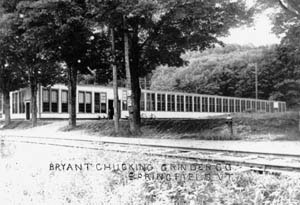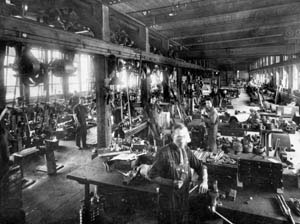History
Bryant Chucking Grinder (more
commonly known as "Bryant Grinder") was founded on March
29, 1909 by William LeRoy Bryant.
William Bryant was an Engineer
at the Jones & Lamson Company during the early 1900's when
he developed the first grinding machine. It was a chucker
model with 3 independent controlled grinding wheels, one
for the OD, one for the ID and one for face grinding, thus,
allowing all surfaces to be ground in one chucking. James
Hartness, President of Jones & Lamson, helped finance the
start up and became the first President of Bryant Grinder.
 By 1910, a 20,000 sq ft building was built on the current
location across the street from J&L. During the same year,
9 machines were shipped to Ford and Cadillac. By 1912, a
single spindle hole grinder was developed, along with two
other models and sales doubled. This provided the first
annual profit of $59.00.
By 1910, a 20,000 sq ft building was built on the current
location across the street from J&L. During the same year,
9 machines were shipped to Ford and Cadillac. By 1912, a
single spindle hole grinder was developed, along with two
other models and sales doubled. This provided the first
annual profit of $59.00.
With the outbreak of World
War I the plant doubled in size, by 1917 running 3 shifts
a day. Additional space was rented from J&L to help produce
artillery shells. The war promotion created two new machine
models especially for the aircraft industry. In fact, Bryant
earned such a reputation for accuracy and precision, virtually
90% of the grinding done on aircraft engines was performed
on Bryant machines up to the advent of the jet engine. During
WWI Ford Aircraft Division had 102 Bryant machines busy
producing the famous Liberty engine.
Firmly established in the automotive
and aircraft sectors, Bryant began producing machines for
the bearing industry. By the end of the twenties, sales
averaged 142 machines per year. The Great Depression arrived,
causing most companies to close. With the start of its first
5-year plan, the Soviet Union became the savior of Bryant
Grinder with annual sales of up to 30% coming from the USSR.
In 1931, William LeRoy Bryant
died. Bryant was replaced by E.J. Fullam, than Treasurer
of the Fellows Company.
With the downturn of the 30's,
improvements were made to the machine designs. Some machines
were made into semiautomatic, hydraulics replaced air and
automatic sizing became available as an option. During this
time motorized spindles became a reality.
 With WWII on the horizon, business was building rapidly.
By 1938, sales had tripled and by 1940, the US Ordnance
Department requested that Bryant expand the building to
127,000 square feet. By 1942, the workforce grew to 1350
people with 200 of them being women. Production peaked at
3.5 machines per day. Demand was so high that 750 machines
had to be built outside by the Draper Corporation, Hopedale,
MA over a two-year period.
With WWII on the horizon, business was building rapidly.
By 1938, sales had tripled and by 1940, the US Ordnance
Department requested that Bryant expand the building to
127,000 square feet. By 1942, the workforce grew to 1350
people with 200 of them being women. Production peaked at
3.5 machines per day. Demand was so high that 750 machines
had to be built outside by the Draper Corporation, Hopedale,
MA over a two-year period.
Bryant was awarded the Army-Navy
E Award in August 1942. With all of the war production in
the "Precision Valley", Springfield, VT ranked No. 7 most
important bombing target in the country.
As the war raged in Europe,
machine production dropped off and Bryant began building
radar units for Raytheon and General Electric. In addition,
Bryant participated in the workings of the highly secretive
Manhattan Atomic Bomb Project. Bryant also worked with Bendix
on grinding bores to .000005" for use on fuel pumps for
the B-29 bombers. This program lead to the development of
the Bryant 1309-W model, designed especially for fuel injection
nozzle production. The first 1309-W was shipped to France
in 1949, followed by 4 domestic shipments and 11 to Japan,
Australia and other European countries. A Bryant grinder
was the first American machine tool to enter Japan after
the war.
In 1946, Joseph B. Johnson,
a long time employee who later became Governor of Vermont,
became Vice President and General Manager. Business was
again slow in the late 40's. But with the Korean War in
the winds, business increased sharply in 1950. This time,
production required two outside builders, Dexter Folder
of Pearl River, NY joined Draper to keep pace with demand.
In keeping with production, the 9" series of machines were
introduced along with the very popular "Centalign C". The
Centalign design was innovative having both traverse motions
of the wheel on one slide and on the same plane as the work
centerline. Demand was so great that Bryant started a subsidiary
in England in 1956. In addition, Bryant purchased the E.G.
Staude Division of Sperry, a manufacturer of printing presses
and packaging machinery.
In the middle 1950's, with
its expertise in spindles, Bryant designed a computer memory
drum, which eventually became a separate division. In 1958,
Ex-Cell-O Corporation of Detroit, MI purchased Bryant by
an exchange of stock. Business again surged and Bryant found
themselves shipping 30% of its product outside the United
States. The Computer Products Division grew very rapidly
and was eventually moved to Walled Lake, MI and rolled into
another Ex-Cell-O division.
Bryant received a very large
order from the Soviet Union for Centalign B grinders in
1960. A year later, after a lot of work was done, the US
Commerce Department revoked the export license. Bryant had
always been known as a leader in machinery export. By 1963,
Bryant was awarded the President's "E" Award for Exports.
The Bryant Centa-Form OD grinding
machine was introduced in 1964, solidifying Bryant's position
in the external grinding market. Business progressed through
the 60's without major interruptions. A mild decline in
business in 1967 lead to a recession in 1971, substantially
reducing the workforce. Bryant acquired the precision external
centerless grinder line from Van Norman in 1972, which further
diversified the Bryant line and contributed to overall sales.
During the 1970's, Bryant continued
to develop technology by introducing 6 new models. But none
compared to the Bryant Lectraline LL3 machine produced in
1979. The LL3 was the first CNC multi-surface grinding machine
in the world. It was later introduced and demonstrated at
the International Manufacturing Technology Show in 1980.
The LL1, LL2 and LL4 size machines were soon to follow,
giving Bryant the capacity of grinding internal diameters
from .040" ID's to 88" OD's.
In the summer of 1986, Ex-Cell-O
and its subsidiaries, including Bryant, were purchased by
Textron, Inc.
In May of 1988, Textron Inc.
sold Bryant Grinder to a financial investment group with
limited experience in the machine tool industry which resulted
in some difficult times for the company, it's customers
and suppliers. During February of 2002, Bryant Grinder suddenly
closed it's doors to business, prompting many to speculate
that the company would never do business again.
On July 18, 2002 Vermont Machine
Tool, founded in 1983 by Craig B. Barrett, purchased the
inventory, work-in-process and all intellectual properties
of Bryant Grinder. Mr. Barrett, formerly with Jones and
Lampson, brought a vision and drive for excellence to the
acquisition as exemplified by seeking out the best qualified
Bryant employees and hiring them to form the core of the
new Bryant Grinder staff. Together with the experienced
crew of Vermont Machine Tool, the new Bryant Grinder team
forms a nucleus of forward looking, motivated and innovative
people intent upon sharing new, creative successes with
their customers.
As corporate America is changing
so is Bryant Grinder under the guidance of Vermont Machine
Tool. Work forces have become smaller as businesses become
leaner. The machine tool industry has changed as foreign
competition has become stronger. Many companies have been
unable to survive.
Bryant Grinder has managed by
producing OD grinders and expanding the CNC versions of
the Lectraform LF2. This model quickly became one of the
best sellers in the modern history of Bryant Grinder. Now
with a full line of Internal and External precision CNC
grinding machines, Bryant intends to maintain its position
in the world as a leading manufacturer of application driven
machine tools.

